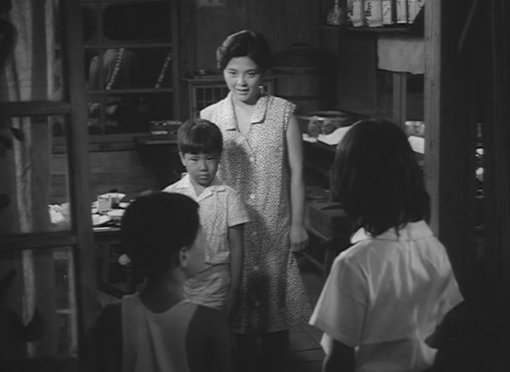It might be hard to contextualize the state of Japanese art film in the 1980s. For whatever reason, it is the least accessible (in terms of distribution, home video release) and least interesting decade in the country’s film production, at least in the west. The golden age of the 1950s was a thing of the past, replaced with kinetic, chaotic, and “radical” aesthetic of the Japanese New Wave and Art Theater Guild that produced most of the “serious” films that came from Japan in the 60s and 70s. Muddy River, which is filmmaker Kohei Oguri’s debut, is a conscious throwback to the aforementioned “golden age” of Japanese cinema, a shomin-geki pastiche. It nails the visual style of that era, while introducing a uniquely quiet tone to the proceedings.
Nobuo lives with his parents in a noodle shop along the river. It functions as the family’s main source of income. He seems to latch on to relationship with other adults because he has no friends that are his age. Nobuo meets Kichi, a boy who seems to be his age. Despite their shy personalities, the two start something of a friendship. Kichi lives in a houseboat along the river with his sister, Ginko and his mother, who we never see. Because of this assumed neglect, Nobuo invites Kichi and Ginko over to his house, both of whom fit in well with Nobuo’s parents and the family’s noodle business. Nobuo’s father promises he’ll take the two boys to an upcoming festival, but then he disappears.
Most of Oguri’s debut is a slow-burn, with excellently photographed frames quietly building into a sequence. However, the film’s opening is as jarring and electrifying a sequence as I’ve ever seen. It follows the aesthetic of the rest of the film, but it is so quick and precise in its commentary. We begin with a shot of the noodle shop, Nobuo greets the guest, a man who drives a horse cart. He’s upset by the visible injury of the man’s ear, but the man erases the tension by offering Nobuo his horse cart. “I’m going to buy a truck” he says, which is followed by some musing on the progression of technology. A few moments later, oncoming traffic jolts the horse, and the cart crushes and kills him. In this short sequence, we get a pretty clear political discourse. Not that the rest of the film is particularly outspoken, but this discourse does mesh with the rest of Oguri’s vision. The horse cart man (which is how everyone refers to him as) is done in by the very thing that prevented his financial demise. Man’s hopeless labor is what keeps him alive, but it is also this labor that kills him, quite literally. The illustration is blunt, and maybe the reason for the scene is more about pathos than politics, but it is representative of the film’s other labors. Pardon the pun, but their work barely keeps them afloat.
It’s worth mentioning that Oguri’s motivations here aren’t one-dimensional, they aren’t strictly related to politics. It’s no surprise that such a political image opens a film that could be categorized as “humanist” when one considers that he is channeling Ozu, Naruse, et al. Those two filmmaker, and a few of their brethren have never been categorized as political filmmakers, but in their work I do see critiques of social infrastructures, but their salience comes from the fact that it’s all woven into something that’s grounded in reality. Yes, “humanist” or whatever, but political because it is personal. Oguri is working from the same template. One might argue that this more importantly a film about disappointment, anguish, and other emotional sensations that aren’t as easy to read, analyze, and study. However, I think they’re are connected.
This is a film told from the perspective of a child and because of that we must assume some naivety. Time is constructed in a opaque way, so we don’t know how time has passed in the film’s duration, but it is a pretty crucial period in Nobuo’s life. In the film’s running time, he confronts death twice, and sex once. It’s interesting that these events are all abstractions of living and loving. I mean, grizzly freak accidents aren’t how we’re meant to encounter our mortality and discovering your best friend’s mother is a sex worker isn’t how we’re meant to discover sexuality. Is there anything inherently wrong about learning about life this way? In Oguri’s hands, these aren’t transgressive moments, but instead common “coming of age” fodder. He frames these moments with such care and grace that their impact on Nobuo isn’t sensationalized. He isn’t quite sure what they mean, and the film isn’t going to force what it should mean to him.
“Coming of age” tales aren’t traditionally framed as stories about the socialization process, but Oguri seems keenly aware that the two are related. The sadness felt by the adults, who are periphery characters, seems like a introduction to children that things aren’t going to be that amazing. Of course, Nobuo, Ginko, and Kichi aren’t particularly upbeat. Kichi seems the least aware of his situation, where as the other two children have come closer to the learning the “harsh truth” or whatever. In reality, I don’t think we just one day lose our innocence and become cynical assholes. It’s a gradual process, one that doesn’t always result in the same type of person. Nobuo is wrestling with his conditions, Ginko has peacefully accepted their limitations (and it’s broken her heart), while Kichi tries to outwardly reject it. It’s important, I think, to clarify that none of these children are meant to represent stages of maturity. Such an idea would undercut the film’s grace, as it is not a work meant to make declarative statements about the unrest of daily existence. We know it’s there, Oguri knows it’s there and we haven’t found the “right” answer to endure the daily struggle. It sucks being a kid, basically.






Liked your review.